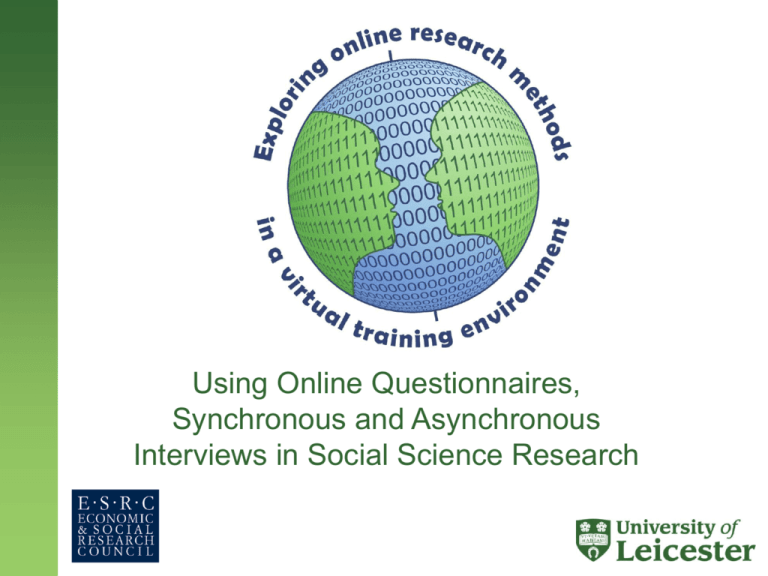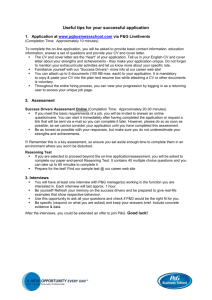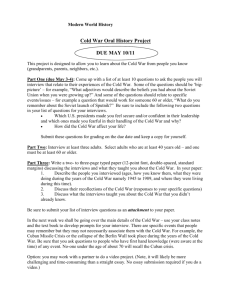PowerPoint - University of York
advertisement

Using Online Questionnaires, Synchronous and Asynchronous Interviews in Social Science Research Session Outline In this session we will: • cover qualitative and quantitative online research; • discuss your experience of online research and offer you some innovative case studies; • talk about how to conduct online research and give you an insight into the participants experience; • show you where to go to find out more about online research. Exploring Online Research Methods Funded by ESRC Research Methods Programme (Phase 2). Website located at www.geog.le.ac.uk/ORM. Comprensive resources about on-line research methods focusing on: • on-line questionnaires; • on-line interviews. Guidance offered on: – ethical issues; – technical issues. Researching Online: Case Study: The Cyberparents Project • Pioneering online research (1998-9) • Increasing number of parenting sites in the UK: http://www.babyworld.co.uk/ • Recognition of the role of the Internet in the lives of new parents and ‘the immense inner sense of security that comes with discovering that real people – most of them parents, some of them nurses, doctors and midwives are available, around the clock if you need them…’ (Rheingold, 1994:16). • Aimed to examine how, why and in what ways new parents use the Internet as an information source about parenting and as a form of social support. • Used combination of online methods: web-based survey and interviews The Research Process • • • • Established contact with Babyworld Interviewed key staff members Access agreed Established webpages for the project within the University website (www.geog.le.ac.uk/baby) – Meet the researchers (included photos of us) – Project information – Survey • Used University crest and linked only to University and babyworld Web-based Questionnaire • Hypertext link from babyworld homepage to our web-based questionnaire • Used ‘hook’ question: ‘are you a cyberparent’ and logo • Clicking on link automatically redirected user to our site • Chose not to use incentive • Web-based questionnaire: • • • • • • Simple and quick to complete Drop down menus Ranking and open questions Final question about further participation Pop up ‘thank you’ once submitted successfully http://www.geog.le.ac.uk/baby/babyworldform.asp On-line synchronous interviews • Rapid results - dwindled after a few days • Sixteen respondents expressed interest in further interview. • • • • Respondents geographically widely dispersed. Many had new babies and/or were pregnant. All internet/technology users. Logical progression to interview online. Software • Debated asynchronous/synchronous interviews; • Hotline Connect conferencing software familiar to researchers was available; • Used as tool for distance learning students; • Facilitates real-time chat through specific server address; • Advantages: – – – – Easy to install on PC and Apple Mac. No need for sophisticated hardware or high technical ability Facilitators have control – confidentiality Low cost The Interview Process • Involved time investment in setting up times/dates and sending/installing software • Synchronous focus group interviews using semi-structured interview schedule • Prepared questions in advance along with ‘script’ and then cut and paste • Worked well but at times unable to use script and other times used it just because we could • Had to use typed words to replace usual visual pointers e.g. building rapport Engagement, Interaction and Communication in Synchronous Online Interviews • Virtual interviews challenge conventional interviewing practices, in particular: – – – – – Rapport building (e.g. lack of visual/physical pointers) Interview design Language use Virtual interface ‘Insiders and outsiders’ • However, ‘the vast majority of social spaces on the internet bear a remarkable resemblance to real world locales’ (Kitchin 1998:395). Visual Clues and Rapport • Textbook guides highlight importance of physical and visual clues in gaining trust, building rapport and ‘assessing’ each other: ‘smile and dress ‘…in a similar way to those you will be interviewing’ (Robson, 1993:236) ‘Your appearance, speech, and behaviour must be acceptable to your research participants’ (Glesne and Peshkin, 1992:95). • Shared characteristics, age, gender, ethnicity, status can have impact. Virtual Rapport • • • • • • Set up web pages with photographs Established relationships via email Tried to stress similarities Carefully designed interview schedule/script Particular focus on sharing profile data Overall this seemed to work well First of all we thought it would be a good idea to introduce ourselves Hello everyone. I'm Clare and I have a daughter called Isabelle who is nearly 2 . I work in the geography department of Leicester University on a 3-day contract and Isabelle is in a local community nursery on those days. I am 35 years old, white and my partner is a psychiatric nurse. I don't use the Internet very often because I am so busy at work and I don't have computer access at home. Hen and Clare: Hi Julia, Jane and Jo, welcome to the chat - could you tell us a bit more about yourselves? Julia: Hi, I am 34 on Sunday (!!) with a daughter, Anabelle aged 10 months. I am a full time mother and am loving avery minute of it. Jane: Hi, I'm Jane, I'm 29 years old, 30 in September. I'm a new mum, with a daughter , Joy who was born on March 15th, so coming up for 3 months now. I'm a stay at home mum, and about to go crazy at times, as she's had colic, and screams like mad.. I love being a mum!! Jo: Hello everyone! I am 33 years old, married and have a 21 month old daughter who I'm sure is starting the terrible twos early! I work part time (reluctantly) but love being a mum. Engagement and Rapport • ‘a stranger wanting to do academic research into online communities is often viewed as an unwelcome arbitrary intrusion’ (Paccagnella, 1997:3) • In this case ‘insider status’ facilitated entry and ‘success’ of method. • Did not encounter the ‘aura of suspicion surrounding stranger to stranger communication in cyberspace’(Smith, 1997:40) Engagement and Rapport • Seems to be tendency to be more open, even to strangers, than in offline encounters • As Poster (1995:90) has argued: ‘Without visual clues about gender, age, ethnicity and social status conversations open up in directions which might otherwise be avoided. Participants in these communities often express themselves with little inhibition and dialogues flourish and develop quickly’ Written Conversation • Changed interview conversation • Interrupting a virtual conversation somehow felt more acceptable in the written word than in the spoken F2F context. • Supportive interactions? • Empathy, smiling, nodding etc.? • Silences and probes - how do you deal with this? • Spellings, paralinguistic expressions e.g. lol, imho, ‘emoticons’ • Less structured and more interactive as questions posted with time lags so final interview transcript littered with interruptions, typos and non-sequential chat. • Real advantage - transcripts ready made Online Interviews: Key Issues • Why use online methods? ‘…if the research question involves an online social phenomenon, a potential strength of the method is to be researching in the location of interest’ (Gaiser, 1997:136). • Type of interview (synchronous or asynchronous) • Software (choice, installation) • Technical ability and access to computer (researcher and subjects) • Venue (convenient, safe space) • Carefully designed interview (prepared text, intros) • Virtual rapport (how can you establish this?) • Technical hitches/language use. Conclusions- the potentials… • Aid interaction with formerly unapproachable groups. • Access to group with shared, narrowly defined interests. • Provide previously unobtainable information and perspectives. • Although sampling problems remain, the indicative data gained from on-line research may be useful for research on population sub-groups and for exploratory analysis. • Savings of time and money. • As on-line research is still in its infancy, many of its potentials are still to be discovered and evaluated. …and the limitations • Novel techniques so while some of their limitations may therefore be solved in time, others may never be remedied. • Indeed although the data collected by virtual interviews, in particular, can be rich and valuable to the researcher, the potential of on-line research should not be exaggerated: many of the issues and problems of conventional research methods still apply in the virtual venue. • While online methodological frameworks are in constant flux, change is not necessarily always progressive: faster and cheaper is not necessarily synonymous with ‘better’. So…. • As Dodd (1998:60) argues, we must ensure that ‘…cheap entry costs and glowing attractiveness of Internet fieldwork do not result in shoddy `cowboy’ research.’ • It is unlikely that online research is going to replace onsite research but rather it is another option in the methodological ‘toolkit’. • Therefore the use of online research methods must themselves be carefully considered. Key sections of the site Introduction Modules Resources Background Detailed breakdown on the Website Overview sheet. Examples: Case Studies Module index Tim Vorley (University Neil Penny Coulson Cholmondeley and of Leicester), Critical Rebecca (University Knibb ofAAlberta). Geography of (University Evaluating the of UK Derby). 'WISEST Biotechnology How (Women an Online in Support Network Scholarship, Affects the of •Featured in a number Experience Engineering,ofScience Living sections. with and Technology)' a Food Allergy. •The case study Resource Network. •This caseisstudy used to displayed a Q+A about discuss • This case recruitment study used for the technical aspects ofto online discuss questionnaires good practice in the questionaire. through gaining consent. soliciting visitors to web sites. Reference tool Site link • While you are using the site you can collect references. • Click on the reference you want to bring up the full reference and add it to your reference list • Choose Open my reference list to see the references you have collected. • Save or print the list before you finish using the site. Summary of the site You can find • Information • Tips/hints • Technical advice • Methodological discussion • Theoretical discussion • Case studies • Learning activities For Research design Solving practical problems Self-directed learning Teaching






